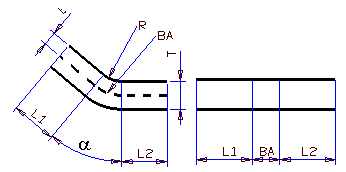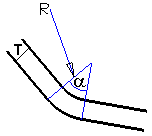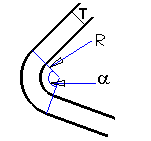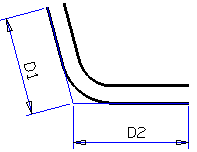
L = L1 + BA + L2
The think3 application supports seven types of bend tables, corresponding to the different ways of computing the Bend allowance value:
The total flat length L is determined as shown in the following illustration:

L = L1 + BA + L2
where:
| R | is the internal bending radius |
| T | is the thickness |
| t | is calculated based on the K-factor (in which case  ) or on the bend table ) or on the bend table |
| a | is the bend angle |
| BA | is the Bend allowance that will be calculated using different formulas based on the type of bend table. |
The K-coefficient (KC) is a deformation coefficient which can be positive or negative (and is different from the K-factor (KF)). The default bend table in the think3 application is based on the K-coefficient.
There are two different formulas used to compute the developed length depending on the bend angle.
 |
If the bend angle is smaller than 90° (a < p/2): while the relation between the K-coefficient and the K-factor is:  |
 |
 |
If the bend angle is greater than or equal to 90° (a ≥ p/2): while the relation between the K-coefficient and the K-factor is:  |
 |
The K-factor is the ratio of distance from the inside face to the neutral line (t) and thickness T:

The Bend allowance BA is the arc length measured along the neutral line (the one between the two red markers in the following illustration).

The following formula will be used to calculate the Bend allowance:

where:
| R | is the internal radius |
| a | is the bend angle in radiants. |
Bend deduction is the length to be subtracted from the developed edges when they are developed just by extending them to their intersection as displayed in the following illustration:

In this case the development length is:
L = D1 + D2 - BD
where BD is the Bend deduction value.
If the bend angle is 90° (a=90°), Bend allowance is:

Bend Table files of type Bend deduction support only an angle of 90°.
For any angle a, Bend allowance is the product of Bend allowance for 90° bend angle and the  ratio:
ratio:
